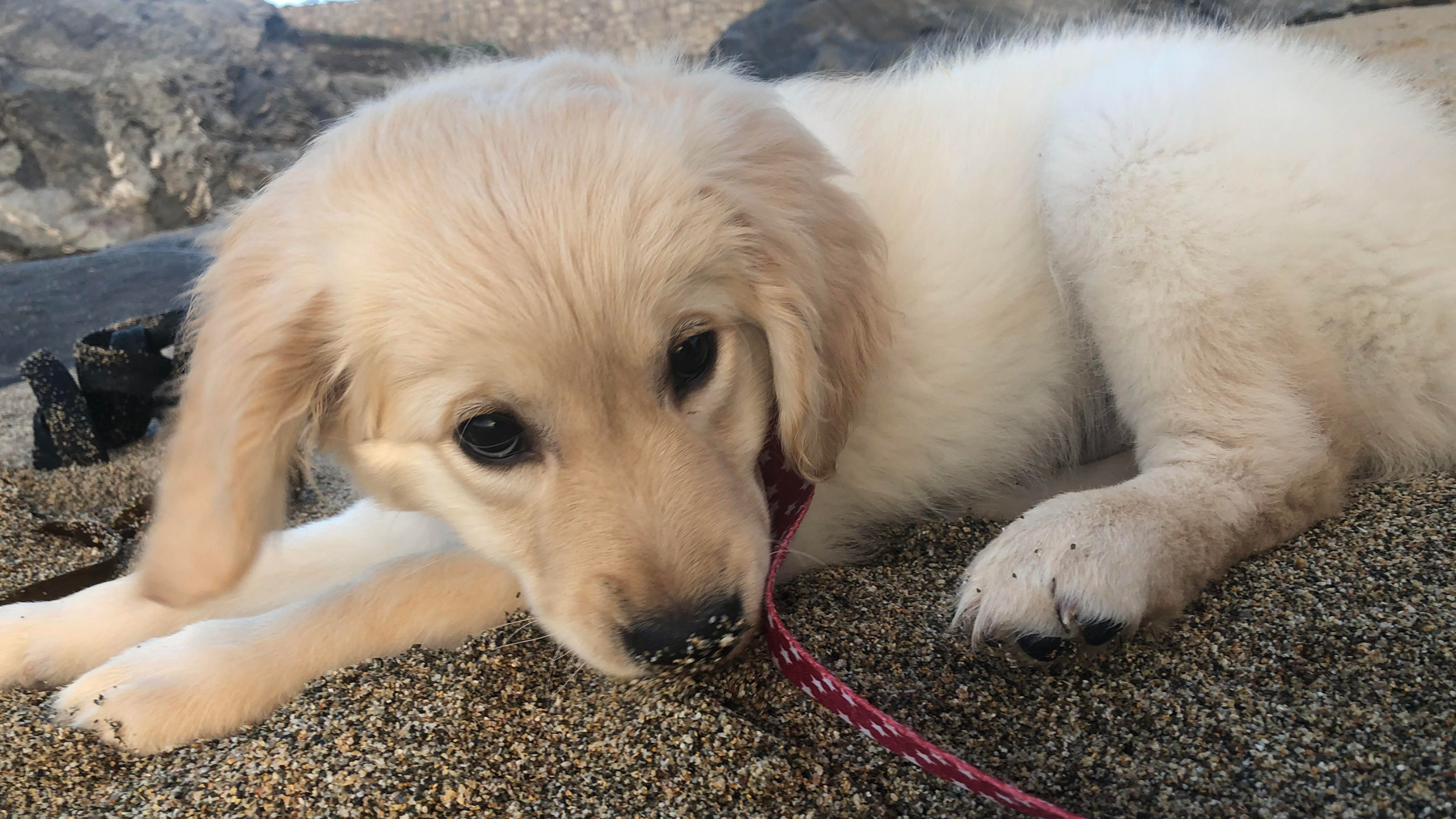I swapped my puppy over to raw food and was shocked at how much it improved her behavior
How changing my puppy's diet made her calmer and easier to train

We picked up our golden retriever puppy, Lowen, in late October last year, just as the clocks were changing. And while I’d argue not much can compete with the cuteness of an 8-week-old puppy, I had forgotten quite how exhausting puppies can be.
Don’t get me wrong, Lowen fit into our home seamlessly from the get-go. My three-year-old daughter was besotted (and thankfully of an age where she could at least vaguely grasp the concept of boundaries and personal space). Spending time watching Lowen develop as she played with the best puppy toys or our slippers became the entire household's favorite pastime. And, perhaps most crucially, the house no longer felt that unique and peculiar unhomely feeling that comes following the loss of a pet - one of the things nobody tells you when your pet dies. We felt complete again.
But (there is always a but) as she grew more confident in her new home and started staying awake for longer periods of time, her behavior became less cute and more, well, annoying. Housetraining was an uphill battle, she had a proclivity for nipping at ankles and she appeared to have an endless supply of energy that no amount of playing could exhaust her of. One evening, in a state of frantic googling, I happened to stumble across the idea of raw feeding…
Why raw food?
It turns out, when it comes to raw food for dogs, there are a lot of strong opinions. I spoke with a few different animal experts to get their take and provide a good overview of the various pros and cons.
“The main benefits of raw diets include healthier skin and a glossier coat, cleaner teeth and smaller amounts of feces produced,” says Dr Lizzie Youens, a practicing vet who provides expert opinions on behalf of Perfect Pet Insurance.
I’d gladly take that - but what about behavior specifically? Gary Roberts is a Master Trainer and Behavior Expert registered with The Guild of Dog Trainers and he believes the effect on behavior from raw feeding comes down to the macros of the food.
“Most raw foods contain 70% to 90% actual meat, 10% to 30% veg and virtually no sugars. Ingredients vary between brands, but some of the best known dry biscuit brands contain as little as 4% meat and as much as 90% carbohydrates,” says Roberts.
Get the best advice, tips and top tech for your beloved Pets
But why, exactly, would this be a problem? These carbohydrates are converted into glycogen, a form of sugar.“We all respond differently to sugar, but the majority of owners switching to raw from dried dog food report a calmer and more focused dog within two weeks,” says Roberts.
But what about the downsides? Emily Norton, Veterinary Department Manager at Woodgreen Pets Charity, is not a fan. “We do not currently endorse the feeding of raw diets to pets in our care, as very few are deemed nutritionally complete without the requirement of added components. Additionally, many of these diets need to remain at below freezing temperatures from manufacturing to feeding, creating a risk to human health if not adhered to,” she says.
Youens was also keen to point out the issue of bacteria. “Feeding your dog a raw diet will potentially expose them and your family to harmful bacteria and other pathogens that can cause serious diseases such as Campylobacter, salmonella and E. Coli,” she says.
Roberts said caution should be exercised and professionals should be consulted if your dog or a family member has a suppressed immune system. However, in other cases you can simply take basic precautions, like handwashing while feeding a raw food . “Bear in mind that dogs will often eat rabbit poo, fox poo, clean their own butt etc. So all things being equal, the fact your dog has eaten raw food a couple of hours ago is likely to be the very least of your worries,” he says.
Any other negatives for raw feeding? “Raw is less convenient and will inevitably cost you more than a cheap food based on grain or rice, and occasionally we come across a dog that just doesn't get on with it,” says Roberts.
On balance, I thought it sounded like something we should try. As a family, we try to eat whole foods and avoid processed foods, so intuitively, it made sense to me to feed our dog following a similar ethos.

Dr Lizzie Youens BSC (HONS) BVSC MRCVS is a practising vet with over ten years of experience, providing expert opinion and commentary on behalf of Perfect Pet Insurance, one of the UK's leading cat and dog insurance providers.

Gary Roberts is a Master Trainer and behavior expert registered with The Guild of Dog Trainers. Over the years he has helped hundreds of dogs and their owners using a combination of cutting edge science and hardwon experience to solve issues including aggression, phobias, separation anxiety, excessive barking and lots more canine issues. He currently offers one to one training, along with training classes and puppy consultations.
Emily joined Woodgreen Pets Charity in 2022 as a Veterinary Department Manager. She oversees a team dedicated to professionalism and quality animal care. She has worked in the scientific pet care sector since completing her undergraduate degree in Animal Science 9 years ago. She has a keen interest in ensuring the most up-to-date veterinary practices are performed, with a focus on shelter medicine and fear-free handling for all types of animals. Pets cross over into both her personal and professional life, and this is only likely to continue.

What changes did we see?
So what actually happened when we made the switch to raw? Within a few days, I noticed quite a big difference in Lowen’s behavior. If I could sum it up in one word I’d say: calmer.
This not only made her more of a pleasure to be around, but it also made her easier to train. One thing that surprised me was that she was having fewer wee accidents in the house. Apparently dry kibble can increase thirst, so it’s normal for a dog on a raw food diet to drink less and therefore need to wee less. A bonus for house training!
From Lowen’s point of view, she seems very content with the swap. She is less pent up and frustrated. Not to mention she wolfs down all her meals in record time.
Like some of the experts mentioned, we have noticed some other benefits too. Her coat is in great condition (although that could well be down to the fact she is a puppy) and her poos are small and odorless. This is because all those carbs in dry food are waste material for the dog so they don't absorb them in the same way as raw.
But what about the negatives? Well, it’s certainly a more expensive option! We also had to upgrade our freezer to a chest freezer to adequately store her food, which was an extra expense. And while it isn’t an inconvenience feeding her raw food at home, I can foresee it being a bit tricky while we’re away on holiday.
On balance, I am very happy with our decision to switch to raw feeding and don’t foresee us going back to kibble.
If you’re interested in learning more, check out our guide to the best raw dog food. “One of the best websites for breakdown and analysis is All About Dog Food. It might be worth visiting and seeing what you are really feeding your dog,” suggests Roberts.
Want to take a deeper dive into what are the benefits of raw dog food? We're here to help or find out is dry dog food best? Before you make the switch, check out our guide on how to change a puppy’s food.

Abby is a freelance writer and dog owner. She currently has two golden retrievers, Lowen and and Indy, but has previously had many other pets, including rabbits.
Abby has written for Metro, House Beautiful, Fit+Well, and more. Alongside this, Abby also volunteers at a local dog rescue centre, helping out with daily activities, such as walking, feeding and grooming.
